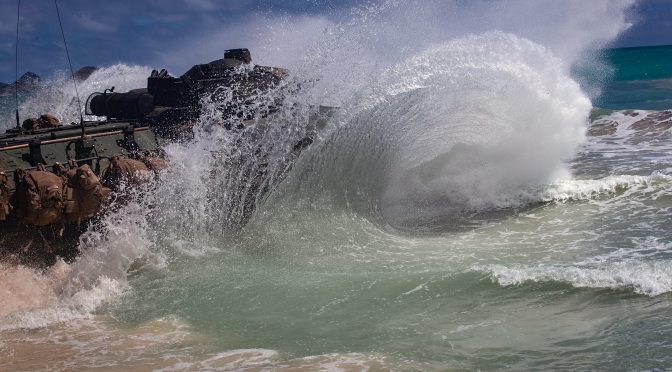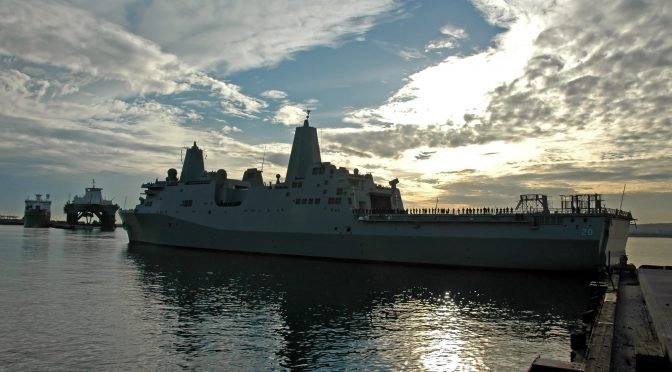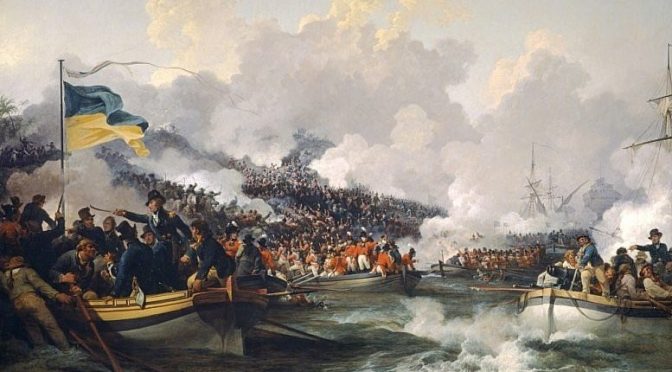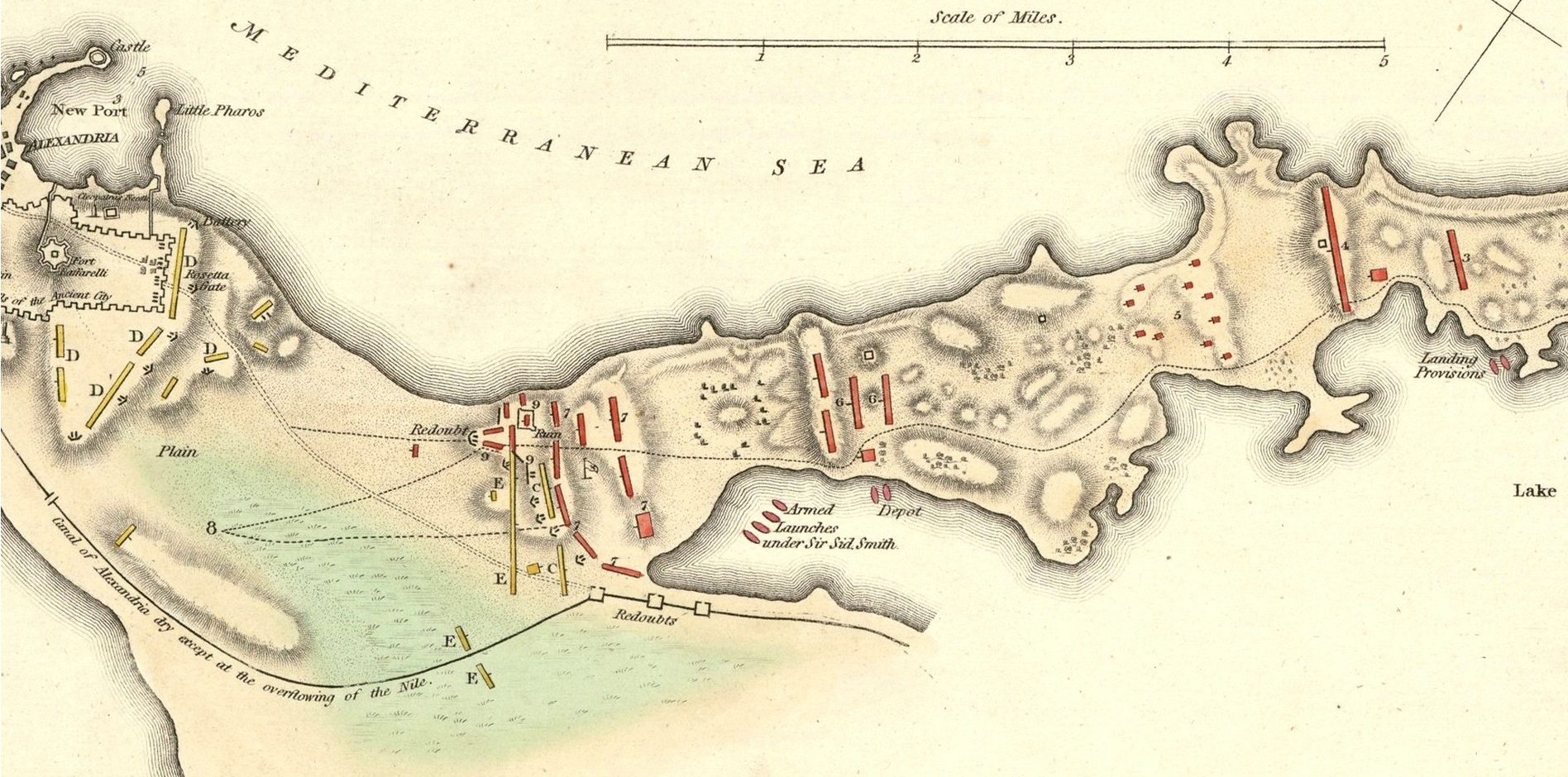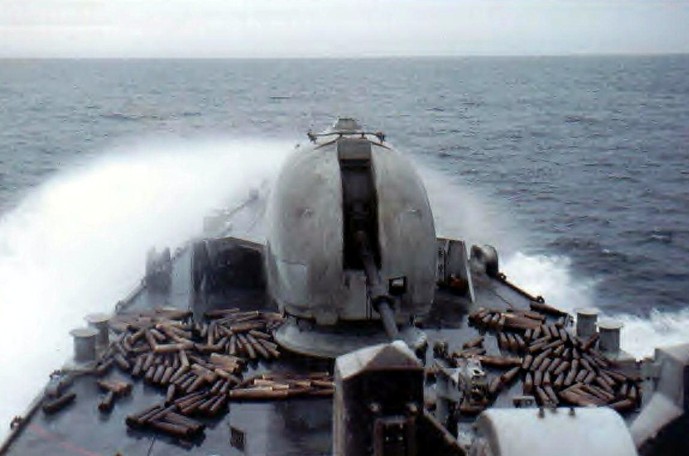Unmanned Maritime Systems Topic Week
By George Galdorisi
Perspective
The United States has entered an era of great power competition against peer adversaries who are seeking to shape the world to their needs and upset the global international order.1 This challenge is addressed in the highest levels of U.S. policy documents, from Global Trends: Paradox of Progress, to the National Security Strategy, to the National Defense Strategy. Indeed, the National Defense Strategy explicitly calls for the United States to “Build a More Lethal Force” to deal with these threats.”2
The U.S. Navy and Marine Corps are critical components of this more lethal force. As the Navy’s Design for Maintaining Maritime Superiority 2.0 (Design 2.0) notes, “The U.S. Navy must be ready to conduct prompt and sustained combat incident to operations at sea.” Design 2.0 also calls for “Deepening integration with our natural partner, the U.S. Marine Corps.”3 As Brigadier General Christian Wortman, Commanding Officer of the Marine Corps Warfighting Lab, noted at the recent USNI/AFCEA West Symposium “We are back and completely integrated with the Navy.”4
This call for enhanced Navy-Marine Corps integration comes at a time when, in the words of a former Marine Commandant, “The Marine Corps is returning to its amphibious roots,”5 and when the demand for amphibious forces is at a high level. As Ryan Hilger noted in his recent CIMSEC article, “Ground Component Commanders (GCCs) continue to signal a demand for amphibious forces, reaching high enough to justify 40 amphibious ships required to meet requested presence requirements.”6
This sea change in U.S. strategic focus comes at a time of accelerating technological change. As Michelle Flournoy, former undersecretary of defense for policy, noted recently, “We are in the most intense technological revolution the world has ever seen.”7 Today, one of the most rapidly growing areas of innovative technology adoption by the U.S. military involves unmanned systems. In the past several decades, the U.S. military’s use of unmanned aerial vehicles (UAVs) has increased from only a handful to more than 10,000, while the use of unmanned ground vehicles (UGVs) has exploded from zero to more than 12,000.
The use of unmanned surface vehicles (USVs) and unmanned underwater vehicles (UUVs) is also growing, as USVs and UUVs are proving to be increasingly useful for a wide array of military applications. The expanding use of military unmanned systems (UxS) is already creating strategic, operational, and tactical possibilities that did not exist a decade ago.
America’s Amphibious Assault Forces: Leading a Paradigm Shift
Last summer, the Smithsonian Channel featured a series, “The Pacific War in Color.” One part of this program told the story of amphibious assaults on Japanese-held islands, such as Iwo Jima, Okinawa, Tarawa, Peleliu, and others. These assaults involved armadas of amphibious ships and hundreds of landing craft that were part of each forcible entry operation. In each case, the attacking force faced significant opposition getting Marines onto the beach.
https://gfycat.com/LeafyImmenseHuman
Aerial raw footage of the 1945 Iwo Jima landings (Romano Archives)
In the post-Cold War era, amphibious assault forces have not been the most capable part of the U.S. Navy. In the years after 9/11—while the Marine Corps was engaged in Iraq and Afghanistan and not primarily embarked on amphibious ships—the amphibious assault fleet was, at best, an afterthought. Today, as the United States faces a plethora of threats across the globe, there is a new emphasis on amphibious warfare.
According to Lieutenant General David Berger, commander of the Marine Corps Combat Development Command, and nominee to be the next Commandant of the Marine Corps, “We need to be prepared for large-scale amphibious operations. We might do it differently in the future, but we can’t ignore it.”8
For decades, when a crisis emerged anywhere on the globe, the first question a U.S. president often asked was, “Where are the carriers?” Today, that question is still asked, but increasingly, it has morphed into, “Where are the expeditionary strike groups?” The reason is clear. These naval expeditionary formations—built around a large-deck amphibious assault ship, an amphibious transport dock, and a dock landing ship—have been the ones used extensively for a wide array of missions short of war, from anti-piracy patrols, to personnel evacuation, to humanitarian assistance and disaster relief. And where tensions lead to hostilities, these forces are the only ones that give the U.S. military a forcible entry option.
U.S. naval expeditionary forces have remained relatively robust even as the size of the Navy has shrunk from a high of 594 ships in 1987 to 272 ships in 2018. Naval expeditionary strike groups comprise a substantial percentage of the current fleet. Indeed, the blueprint for the future fleet the Navy is building, as seen in a recent Congressional Research Service report, maintains—and even increases—that percentage.9
An article in Marine Corps Gazette highlighted Marine Corps thinking on future amphibious assault operations:
“While forcible entry operations are often thought of exclusively in terms of initiating a continental campaign, an application some analysts assume to be unlikely, it may be more probable in the 21st century that they are conducted as part of a joint campaign that is maritime in character. It ought to be self-evident from looking at a map that military competition in the near seas will involve an amphibious component—to include amphibious assault when and where required.”
The Gazette article goes on to note that “a film about a modern amphibious operation would likely be boring, as there would be no dramatic scenes of large units fighting their way across a heavily defended beach.”10
Navy and Marine Corps expeditionary forces have been proactive in looking to affordable new technology to add capability to their existing and future ships. One of the technologies that offers the most promise in this regard is unmanned systems. These unmanned systems can reduce the risk to human life in high-threat areas, deliver persistent surveillance over areas of interest, and provide options to warfighters—particularly given their ability to operate autonomously.
The U.S. Navy’s commitment to unmanned systems is seen in the Navy’s Force Structure Assessment, as well as in a series of Future Fleet Architecture Studies. In each of these studies—one by the CNO staff, one by the MITRE Corporation, and one by the Center for Strategic and Budgetary Assessments—the proposed future fleet architecture featured large numbers of air, surface, and subsurface unmanned systems.11 These reports highlight the fact that the attributes unmanned systems can bring to the U.S. Navy Fleet circa 2030 have the potential to be transformational.
One of the major challenges to the Navy and Marine Corps to making a substantial commitment to unmanned maritime systems is the fact that they are relatively new and their development has been under the radar for all but a few professionals in the research and development, requirements, and acquisition communities. That is now changing. The Department of Defense 2017-2037 Unmanned Systems Roadmap highlights a large number of Navy and Marine Corps unmanned systems, particularly unmanned maritime systems (USVs and UUVs).12
Design 2.0 has clearly articulated the importance of unmanned systems to the Navy and Marine Corps future warfighting effectiveness. The publication’s “Line of Effort Green: Achieve High Velocity Outcomes,” demonstrates the Navy’s commitment to making unmanned systems a key component of the future fleet, highlighting air, surface and subsurface unmanned systems.13 Additionally, this commitment to unmanned systems programs is reflected in program documents such as the 2018 Navy Program Guide and the 2018 Marine Corps Concepts and Programs.
The Navy and Marine Corps have taken the lead in orchestrating an unprecedented number of exercises, experiments, and demonstrations to introduce new, cutting edge technologies—especially unmanned maritime systems—into the Fleet and Fleet Marine Forces. Many of these technologies are mature commercial off-the-shelf systems that are currently being used for other military and commercial applications. These events have put new technology directly into the hands of Sailors and Marines and have accelerated the amphibious force renaissance.
Testing and Evaluating Unmanned Systems
During the recent USNI/AFCEA “West” Symposium, Chief of Naval Operations Admiral John Richardson noted, “Our strategic Achilles Heel is our inability to get new technology into the hands of our warfighters fast enough.”14 This is especially true with emerging technologies that are revolutionary—not merely evolutionary.
As with many novel naval technologies: ironclads, submarines, aircraft, nuclear power, directed-energy weapons, as well as others, is it typically not the most prominent communities where this experimentation takes place, but rather, in those parts of the Navy and Marine Corps that have traditionally been out of the spotlight and who need a technology boost. Today, it is the amphibious assault Navy that has been notably proactive in experimenting with emerging unmanned systems.
The Navy and Marine Corps have a number of ways to test and evaluate unmanned maritime systems. While some of this testing and evaluating—especially in the early stages of unmanned maritime systems development—occurs at industry facilities or at U.S. Navy laboratories, once these systems are more mature, they are fielded in a wide-array of Navy and Marine Corps events in the operational environment where they will ultimately be used. Brigadier General Wortman emphasized this point during the USNI/AFCEA Wes” Symposium where he noted, “We need to do more Fleet and MEF level exercises.”15
As the Department of the Navy has become increasingly interested in unmanned maritime systems, this testing and evaluating has accelerated in a number of exercises, experiments and demonstrations, such as the Ship-to-Shore Maneuver Exploration and Experimentation (S2ME2) Advanced Naval Technology Exercise (ANTX), the Surface Warfare Distributed Lethality in the Littoral Demonstration, and the Navy-Marine Corps Bold Alligator series of exercises.
The Ship-to-Shore Maneuver Exploration and Experimentation Advanced Naval Technology Exercise is a prime example of the Department of the Navy’s push to test and evaluate unmanned maritime systems. S2ME2 ANTX was especially important to the Navy and Marine Corps as the amphibious ship-to-shore mission is one of the most challenging tasks the military must undertake.
Due to the enormous stakes involved in putting troops ashore in the face of a prepared enemy force, S2ME2 ANTX had a heavy focus on unmanned systems—especially unmanned surface systems—that could provide intelligence, surveillance, and reconnaissance (ISR) as well as intelligence preparation of the battlespace (IPB). These are critical missions that have been traditionally been done by Sailors, Marines, and Special Operators, but ones that put these warfighters at extreme risk.
There is growing realization of the need to insert new technology to make the amphibious assault force more effective in the face of robust adversary defenses. In an address at the 2018 Surface Navy Association Symposium, Marine Corps Major General David Coffman, Director of Expeditionary Warfare (OPNAV N95), noted the need to make U.S. Navy amphibious ships, “More viable, lethal and survivable, with a focus on command, control, communications, computers, cyber and intelligence (C5I).”16 Clearly, the ISR and IPB missions depend on these capabilities, and it is unmanned systems that can provide this function without hazarding personnel.
During the S2ME2 ANTX the amphibious assault force proactively employed an unmanned surface vehicle to thwart enemy defenses. A MANTAS USV (an eight-foot version of a family of stealthy, low profile, USVs) swam into the “enemy” harbor (the Del Mar Boat Basin on the Southern California coast), and relayed information in real-time to the amphibious force command center using its TASKER C2 system. Subsequent to this ISR mission, the MANTAS USV was driven to the surf zone to provide IPB on water conditions, beach gradient, obstacle location and other information crucial to planners prior to a manned assault.
Carly Jackson, Naval Information Warfare Center Pacific’s Director of Prototyping for Information Warfare and one of the organizers of S2ME2 ANTX, explained the key element of the exercise was to demonstrate new technology developed in rapid response to real world problems facing the fleet and noted that the exercise was focused on unmanned systems with a big emphasis on intelligence gathering, surveillance, and reconnaissance.17
In many ways, S2ME2 ANTX was a precursor to Bold Alligator, the Navy-Marine Corps exercise designed to enhance interoperability in the littorals. Bold Alligator was a live, scenario-driven exercise designed to demonstrate maritime and amphibious force capabilities. The 2nd Marine Expeditionary Brigade (MEB) led the exercise and operated from dock landing ships USS Fort McHenry (LSD-43) and USS Gunston Hall (LSD-44); amphibious transport dock USS Arlington (LPD-24).18
Bold Alligator took the concepts explored during S2ME2 ANTX to the next level, employing two different size (six-foot and twelve-foot) MANTAS USVs in the ISR and IPB roles to provide comprehensive reconnaissance of beaches and waterways. These systems were employed during the Long Range Littoral Reconnaissance phase of the exercise.
The 2nd Marine Expeditionary Brigade used the larger (twelve-foot) MANTAS USV, equipped with a Gyro Stabilized SeaFLIR230 EO/IR Camera and a BlueView M900 Forward Looking Imaging Sonar to provide ISR and IPB for the amphibious assault. This sonar was employed to provide bottom imaging and analysis within the surf zone of the amphibious landing area. This latter capability is crucial in amphibious operations in order to ensure that a landing craft can successfully enter the surf zone without encountering mines or other objects.
While S2ME2 was confined to a relatively constrained operating area off the coast of Southern California, Bold Alligator was played out over a wide geographic area. This included a Command Center at Naval Station Norfolk, Virginia, and operating units employing forces in a wide area of the Atlantic Ocean, North and South Onslow Beach, Camp Lejeune, North Carolina, as well as in the Intracoastal Waterway near Camp Lejeune.
During the Long Range Littoral Reconnaissance phase of Bold Alligator, Navy and Marine Corps operators at Naval Station Norfolk were able to remotely control both the six-foot and twelve-foot MANTAS USVs and drive them off North and South Onslow Beaches as well as in the Intracoastal Waterway. Once positioned, both MANTAS USVs streamed live, high-resolution video and sonar images to the command center at Naval Station Norfolk several hundred miles away.
The latter capability is crucial in amphibious operations in order to ensure that a landing or other craft could successfully navigate a waterway or enter the surf zone without encountering mines or other objects. Clearing a path for LCACs or LCUs to safely pass through the surf zone and onto the beach during an assault is a make-or-break factor for any amphibious operation. Having the ability to view these images in real-time enables decision makers not on-scene to make time-critical go/no go determinations. The value of providing commanders with real-time ISR and IPB is difficult to overstate, and it is likely that this capability will continue to be examined in other expeditionary exercises going forward.
Sustaining the Amphibious Assault Force Renaissance
The ship-to-shore movement of an expeditionary assault force was—and remains—the most hazardous mission for any navy. The value of real-time ISR and IPB is difficult to overstate. It is this ability to sense the battlespace in real time that will spell the difference between victory and defeat.
For this reason, it seems clear that the types of unmanned systems the Department of the Navy should acquire are those systems that directly support naval expeditionary forces that conduct forcible entry operations. This suggests a need for unmanned surface systems to complement our expeditionary naval formations represented by the amphibious assault navy. These commercial off-the-shelf technologies are available today and the Department of the Navy would be well-served to put them into the hands of warfighters now.
Captain George Galdorisi (USN – retired) is a career naval aviator whose thirty years of active duty service included four command tours and five years as a carrier strike group chief of staff. He began his writing career in 1978 with an article in U.S. Naval Institute Proceedings. He is the Director of Strategic Assessments and Technical Futures at the Naval Information Warfare Center Pacific in San Diego, California.
The views presented are those of the author, and do not reflect the views of the Department of the Navy or Department of Defense.
References
[1] Global Trends: Paradox of Progress (Washington, D.C.: National Intelligence Council, 2017), accessed at: https://www.dni.gov/index.php/global-trends-home.
[2] The National Defense Strategy (Washington, D.C.: Department of Defense, January 2018)
[3] Design for Maintaining Maritime Superiority 2.0 (Washington, D.C.: Department of the Navy, December 2018) accessed at: https://www.navy.mil/navydata/people/cno/Richardson/Resource/Design_2.0.pdf.
[4] Brigadier General Christian Wortman, panel remarks, USNI/AFCEA “West” Symposium, February 13-15, 2019.
[5] Otto Kreisher, U.S. Marine Corps Is Getting Back to Its Amphibious Roots, Defense Media Network, November 8, 2012, accessed at: https://www.defensemedianetwork.com/stories/return-to-the-sea/.
[6] Ryan Hilger, Cost and Survivability: Acquiring the Gator Navy,” Center for International Maritime Security, April 8, 2019, accessed at: https://cimsec.org/cost-and-survivability-acquiring-the-gator-navy/39784
[7] Michelle Flournoy, keynote remarks, Second Front “Offset Symposium,” March 5, 2019.
[8] Lieutenant General David Berger, keynote remarks, National Defense Industrial Association Expeditionary Warfare Conference, Annapolis Maryland, October 16-18, 2018.
[9] Navy Force Structure and Shipbuilding Plans: Background and Issues for Congress (Washington, D.C.: Congressional Research Service, October 19, 2018).
[10] George Galdorisi and Scott Truver, “The U.S. Navy’s Amphibious Assault Renaissance: It’s More than Ships and Aircraft,” War on the Rocks, December 12, 2018.
[11] See Navy Project Team, Report to Congress: Alternative Future Fleet Platform Architecture Study, October 27, 2016, MITRE, Navy Future Fleet Platform Architecture Study, July 1, 2016, and CSBA, Restoring American Seapower: A New Fleet Architecture for the United States Navy, January 23, 2017.
[12] Department of Defense Unmanned Systems Integrated Roadmap 2017-2042 (Washington, D.C.: Department of Defense, August. 28, 2018).
[13] Design for Maintaining Maritime Superiority 2.0.
[14] Admiral John Richardson, Chief of Naval Operations, keynote address, USNI/AFCEA “West” Symposium, February 13-15, 2019.
[15] Brigadier General Christian Wortman USMC, Commanding Officer Marine Corps Warfighting Lab, Panel remarks, USNI/AFCEA “West” Symposium, February 13-15, 2019.
[16] Meagan Eckstein, “Navy, Marines Eyeing Ship Capability Upgrade Plans that Focus on Weapons, C5I,” USNI News, January 17, 2018, accessed at: https://news.usni.org/2018/01/17/navy-marines-eyeing-ship-capability-upgrade-plans-focus-weapons-c5i?utm_source=USNI+News&utm_campaign=3de4951649-USNI_NEWS_DAILY&utm_medium=email&utm_term=0_0dd4a1450b-3de4951649-230420609&mc_cid=3de4951649&mc_eid=157ead4942.
[17] Patric Petrie, “Navy Lab Demonstrates High-Tech Solutions in Response to Real-World Challenges at ANTX17,” CHIPS Magazine Online, May 5, 2017, accessed at http://www.doncio.navy.mil/CHIPS/ArticleDetails.aspx?id=8989.
[18] Information on Bold Alligator 2017 is available on the U.S. Navy website at: http://www.navy.mil/submit/display.asp?story_id=102852.
Featured Image: MARINE CORPS BASE HAWAII, Hawaii (April 9, 20190) A U.S. Marine Corps amphibious assault vehicle assigned to Combat Assault Company, 3d Marine Regiment, crashes into the tides as it enters the water during an amphibious assault exercise at Marine Corps Training Area Bellows, Marine Corps Base Hawaii, Apr. 9, 2019. The unit conducted a simulated beach assault to improve their lethality and cooperation, as a mechanized unit and force in readiness. (U.S. Marine Corps photo by Sgt. Alex Kouns)

